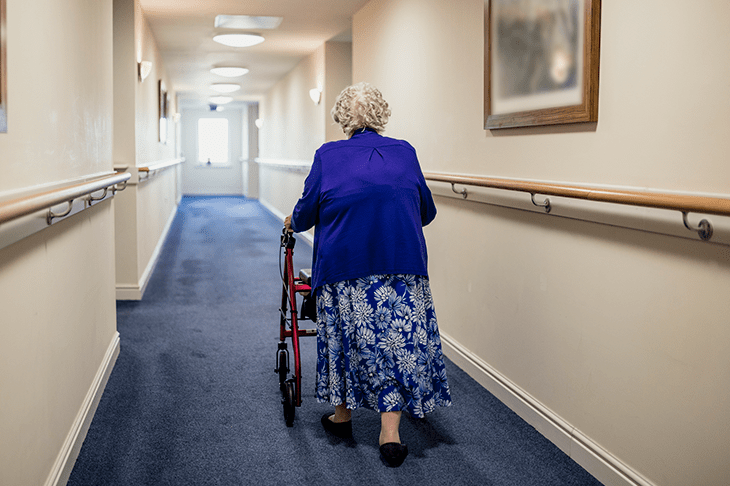Cases of coronavirus are on the rise again inside care homes. Last week, Public Health England reported that 35 care homes had ‘infection incidents’ linked to Covid. And an internal Department of Health memo suggested that ‘satellite tests’ — which mainly take place in care homes — were picking up an estimated 1,100 new cases every day.
This is extremely worrying for the most vulnerable people in our society — almost half of Covid deaths in the UK, more than 19,000, have been in care homes — but especially worrying when you look at the care regulatory system presided over by the Care Quality Commission (CQC). As far as I can tell, England’s official care regulator has been actively stifling attempts to understand why so many people died — in particular, whether the deaths occurred in homes which the regulator had known were unsafe.
Under the CQC’s regulatory system, based on school inspections, each care facility in England is visited and given a rating on a sliding scale from Outstanding, through Good and Requires Improvement to In-adequate. Currently, one in five care homes for older people in England have officially failed their CQC inspections — they were either ‘Requires Improvement’ or simply ‘Inadequate’. That means some 2,000 are sitting on negative reports — including more than 150 which have officially been labelled inadequate.
In report after report, the biggest failing, almost invariably, was that they did not provide adequately ‘safe’ care, because of a lack of staff and a lack of understanding of basic good practice. And as the CQC acknowledges, badly run homes can leave residents vulnerable to abuse and infection.

Typically, bad homes do not have enough staff — residents can remain in bed all day or be left to sit in a high-backed chair in a lounge alongside numerous others. Anything can and does happen. Some reports are horrifying, revealing elderly people losing weight for want of food and being left in filthy clothes — or even not being bathed for weeks. Some homes have regular outbreaks of illness, with sickness bugs and chest infections spreading rapidly through the frail residents. According to one recent report: ‘Staff… understood the need to use gloves and aprons, but good practice was not always followed.’
Early on, in addition to worries about the lack of PPE, critics began to voice concerns about Covid potentially being spread by agency staff who could take the virus from home to home. But it wasn’t just the itinerant workforce: the whole situation was ripe for disaster. Those hundreds of facilities condemned by inspectors were — perhaps still are — like cars stuck on the railway tracks with an express train heading their way.
To understand why the virus was able to wreak havoc across the sector and to prevent it happening again, it is essential to know to what extent unsafe homes were affected. In June, the regulator said: ‘We have continued to inspect in response to risk and concerns raised, and services have remained subject to close monitoring using a range of intelligence sources.’ But for all the intelligence sources and sophisticated IT systems, the CQC still refuses to disclose how many cases and deaths occurred in homes inspectors had raised concerns about.
Currently, one in five care homes for older people in England have officially failed their inspections
At first, the CQC completely ignored my requests for this information. Then, on 2 June, a spokesman emailed me: ‘I am absolutely not refusing to answer your questions. Our data team are extremely busy right now, I will chase this up and come back to you today with more information.’ But he did not come back to me. In July, I put in a Freedom of Information Act request. Two weeks ago, the CQC finally responded and this time officially refused to provide the data: ‘We require additional time to conduct a public interest test to consider whether the balance of public interest favours withholding the data until analysis is ready for publication. We hope to be able to provide a response to this part of your request within two weeks.’
A recent report on one Bupa home said: ‘At the last inspection this key question [safety] was rated as Requires Improvement. At this inspection this key question has now deteriorated to Inadequate. This meant people were not safe and were at risk of avoidable harm.’
What, one wonders, could be the public interest in withholding the data on such homes? So far, blame for the Covid crisis in care homes has been levelled at the government, for insufficient PPE provision, and at NHS bosses, who sent virus victims into homes without warning. If the CQC were to admit how many Covid-hit homes were already known to be unsafe, it might well raise awkward questions.
Bad care homes, where people are at risk of infection, are routinely allowed to continue in business, even during a pandemic — because closure is seen as an even worse option. Many homes have not had a ‘Good’ report in the five years since the inspection system was introduced. It is not unusual for a home to have received five, six or seven bad reports — and still be ‘caring’ for vulnerable residents. In one report last February, when Covid was already on the horizon, the inspectors found that in one home: ‘People were not consistently protected by the prevention and control of infection. We observed a staff member was not following safe practice in relation to hygiene and infection control and had not used appropriate protective personal equipment.’
For now, it is impossible to know how great a factor this has been in Covid care-home deaths. But the CQC has admitted that it has received reports of ‘poor infection prevention and control’ in some care homes, including those which had an outbreak of Covid-19. A UCL study published in August also found that Covid outbreaks were worse in homes where there was a higher resident-to-staff ratio, and where ‘organisational factors’ were likely to have impacted the implementation of infection control procedures.
Nearly two years ago, the Competition and Markets Authority said care home residents are protected by consumer law — they could sue or demand refunds if they received a substandard service. Bereaved families might quite reasonably ask for compensation from the sector.
In its refusal to shed light on which homes were most affected by Covid, even in the abstract, the CQC looks increasingly as though it is held captive by a care sector that is intent on avoiding responsibility.
Care-industry insiders complain that local authorities do not pay enough for care, which leads to poor standards. But why then are some homes which rely on pitiful amounts from publicly funded residents ‘Outstanding’ and other high-end homes, which charge self-funding residents £1,000 a week, deemed unsafe? With the right attitude and the right management, and with the right regulator, decent care should be possible, but that will require honesty and transparency.






Comments